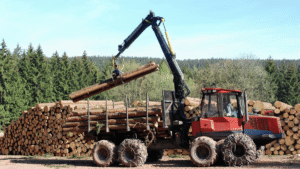Forestry play a critical role in the ecosystem, providing habitat for wildlife, regulating the water cycle, and serving as a carbon sink to mitigate the effects of climate change. The forestry industry is responsible for managing these forests to ensure they remain healthy and sustainable.
What is Precision Forestry?
Precision forestry is an approach to forest management that uses technology and data to make informed decisions about forest management practices. It involves the use of remote sensing, geographic information systems (GIS), and other technology to collect data on the forest and its environment. This data is then analyzed to identify patterns and trends and used to make decisions about forest management practices such as planting, thinning, and harvesting.

The goal of precision forests is to optimize the use of resources, reduce waste, and improve the health and productivity of the forest. By using technology and data to make decisions about forest management, precision forest helps to reduce the environmental impact of forest and ensure the long-term sustainability of the forest.
What is Sustainable Forest Management?
Sustainable forest management is an approach to forest management that aims to balance the economic, social, and environmental benefits of the forest. It involves managing the forest in a way that conserves its natural resources and biodiversity while also providing benefits to local communities and the global economy.
Sustainable forest management requires a holistic approach to forest management, taking into account the interdependence of the different components of the forest ecosystem. This includes managing the forest for the protection of water quality and quantity, soil health, wildlife habitat, and air quality, as well as for the production of wood and non-wood forest products.
The goal of sustainable forest management is to ensure the long-term health and sustainability of the forest, while also providing economic benefits to local communities and the global economy.
The Benefits of Precision Forestry and Sustainable Forest Management:
The implementation of precision forestry and sustainable forest management practices provides numerous benefits, including:

- Increased efficiency and productivity: By using technology and data to make informed decisions about forest management, precision forest helps to maximize the benefits of the forest while minimizing waste and inefficiencies.
- Improved forest health: Sustainable forest management practices help to conserve the natural resources and biodiversity of the forest, improving its health and productivity.
- Reduced environmental impact: By minimizing waste and inefficiencies, precision forestry and sustainable forest management practices help to reduce the environmental impact of forestry.
- Economic benefits: By providing a sustainable source of wood and non-wood forest products, precision forestry and sustainable forest management practices help to provide economic benefits to local communities and the global economy.
Challenges to Implementing Precision Forestry and Sustainable Forest Management:
There are several challenges associated with implementing precision forestry and sustainable forest management practices, including:
- Cost: The cost of implementing precision forestry and sustainable forest management practices can be high, particularly for small and medium-sized forestry operations.
- Lack of technology and data: In some areas, there may be a lack of technology and data necessary to support precision forestry practices, making it difficult to implement these practices effectively.
- Lack of knowledge and expertise: There may be a lack of knowledge and expertise among forestry professionals, particularly in developing countries, making it difficult to implement precision forestry and sustainable forest management practices.
- Socio-economic barriers: In some areas, there may be socio-economic barriers to implementing precision forestries and sustainable forest management practices, such as resistance from local communities or difficulties in securing financing.
Conclusion
Precision forestry and sustainable forest management are critical approaches to forest management that aim to maximize the benefits of forests while minimizing their impact on the environment.
By using technology and data to make informed decisions about forest management, precision forest helps to reduce waste and inefficiencies, improve forest health, and reduce the environmental impact of the forest. Sustainable forest management, on the other hand, takes a holistic approach to forest management, balancing the economic, social, and environmental benefits of the forest.
Despite the numerous benefits of precision forest and sustainable forest management, there are several challenges to their implementation, including cost, lack of technology and data, lack of knowledge and expertise, and socio-economic barriers.
However, with continued investment in technology and data, and increased awareness and education about the importance of these approaches, it is possible to overcome these challenges and implement precision forestry and sustainable forest management practices on a global scale.
In conclusion, precision forest and sustainable forest management are key to ensuring the long-term health and sustainability of forests and play an important role in mitigating the effects of climate change and preserving the environment for future generations.
The forestry industry must continue to invest in these approaches and work towards their widespread implementation in order to maximize the benefits of forests and conserve their natural resources for generations to come.










